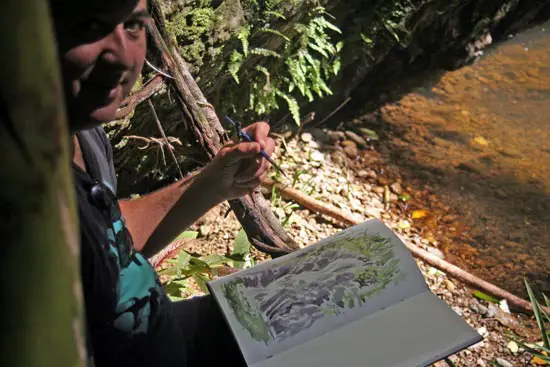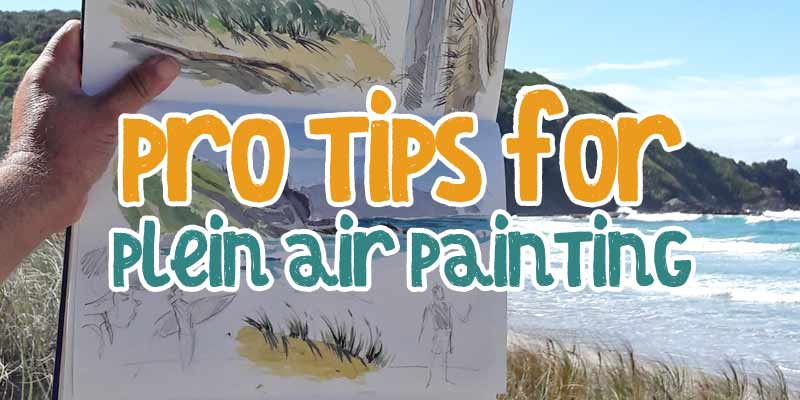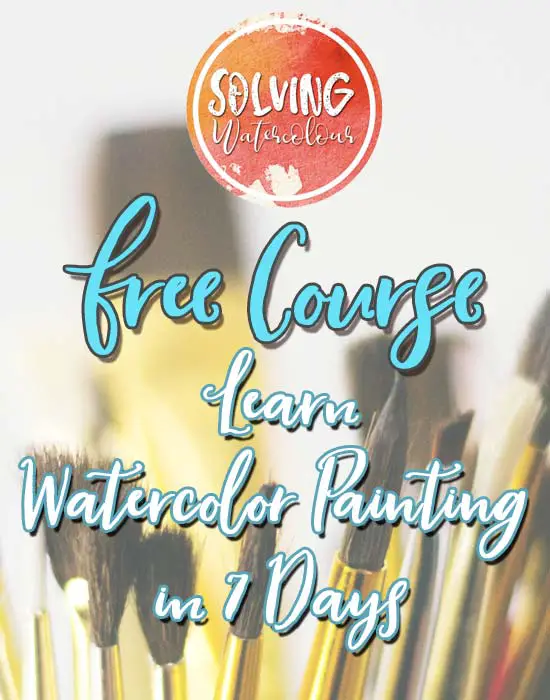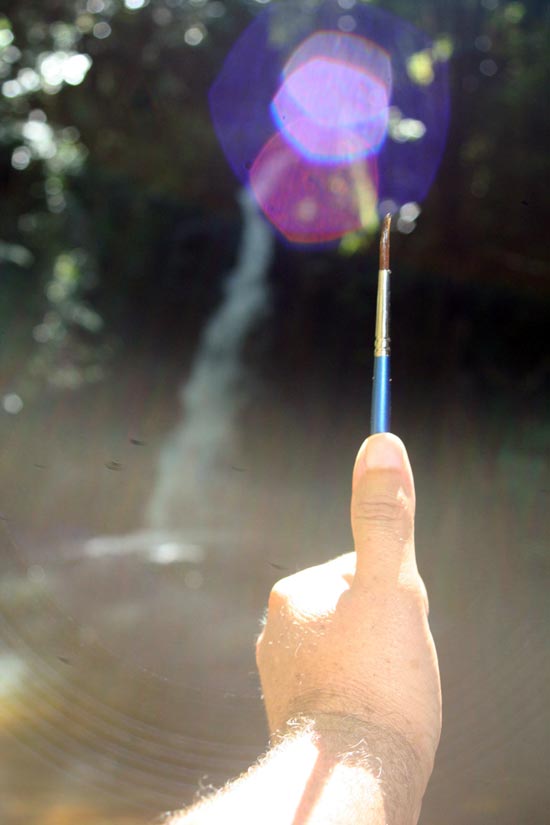
In this post I’ll do much more than just give you some great tips for Plein Air watercolor painting (Though I’ll do that too). I’ll also give you some convincing reasons why it’s something that every painter should try and give you some ways to overcome any reluctance you may have to get started.
What Is “Plein Air” Painting?
The term “En Plein Air”, is a French term that simply means “Outdoors”. In the early 19th Century, it became possible for artists to move out of the studio and start painting outside. This was made possible by the invention of tube paints along with portable easels and canvases.
Why Should I Do Plein Air Painting?
There is no doubt that working indoors in a comfortable studio environment has many practical advantages. So why venture outside?
Working indoors means working from photographs, and photographs have an inherent limitation. I’ve discussed this before in my post on landscape painting from photos . Photographs take us several steps away from reality. They limit our experience to just the visual. Not only that, they distort and flatten reality and confine it within a rectangular border.

The first time that I tried Plein Air painting, I was pleasantly surprised at how fresh and spontaneous my work suddenly looked. It had a noticeably different appearance to anything that I had ever done in the studio. I didn’t have time for caution or excessive planning, The rapidly changing light combined with the unpredictable weather conditions meant that I had no choice but to put my conscious mind on hold and work as quickly as possible immersing myself in the moment.
Getting Started With Plein Air Watercolor
Advantage of watercolor over other media is its speed and simplicity. Not that it is simple to master but at least you don’t have all the complexity of oil painting with it’s ratios of turpentine to linseed etc.
Before we delve into the practicalities and challenges of Plein Air, it’s worth taking a moment to decide what it is that you are trying to achieve.
If you want to create a finished piece of artwork that you can frame and sell, this is certainly possible to do and many artists do it but you will need an easel of some kind and accept that you may end up drawing a certain amount of attention to yourself.
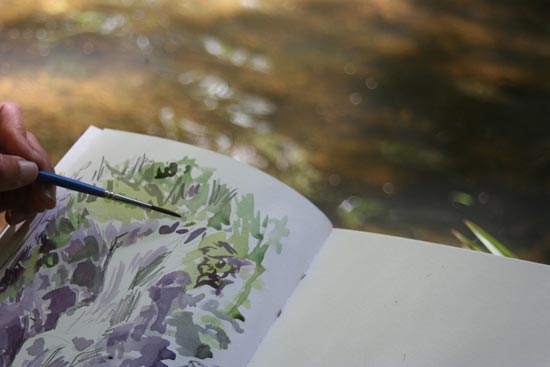
Personally, I mainly paint outdoors in order to create sketches to use as reference for finished pieces of work. I also like to challenge myself and push my artistic boundaries. We’ll take a more detailed look at the
equipment that you will need later on in this post.
How To Get Over Your Fear Of Plein Air Painting
Stage fright is a very real phenomena. We are visual artists not stage performers at least most of us probably aren’t. Artists are often sensitive souls, unaccustomed and reticent to command center stage. Perhaps you’re just starting out and don’t feel ready to expose your fledgling work to the gaze of the public. It’s perfectly normal to feel this way.
Don’t let that put you off. The good news is, you don’t have to go all in straight away. Only the bravest souls would for example setup an enormous easel in the middle of the town square and start painting away.
Start with some discreet pencil sketches in a small sketchbook while you’re at the beach or a park. It’s unlikely that you’ll even be noticed.
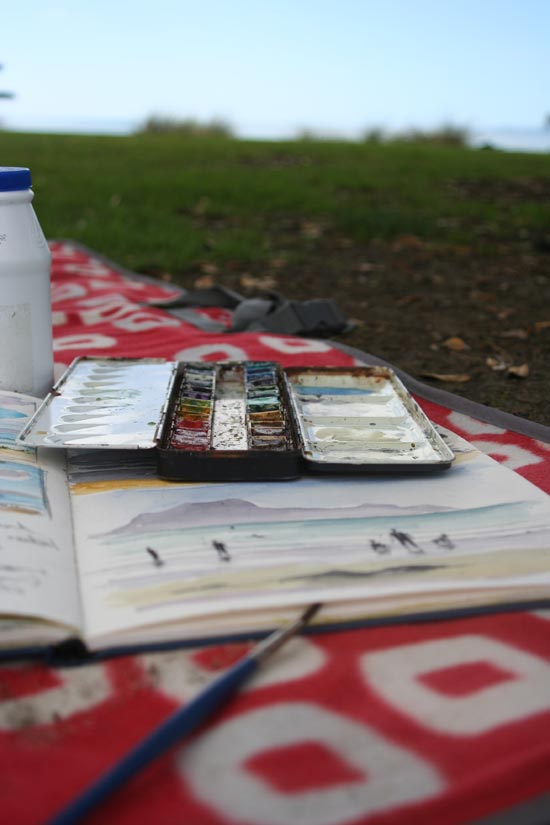
An easel will probably draw peoples attention to you but you don’t actually have to use one, I don’t, but it can be a bit awkward trying to hold a sketchbook and paint at the same time. Here I am (Below) at Cheltenham beach in Auckland.
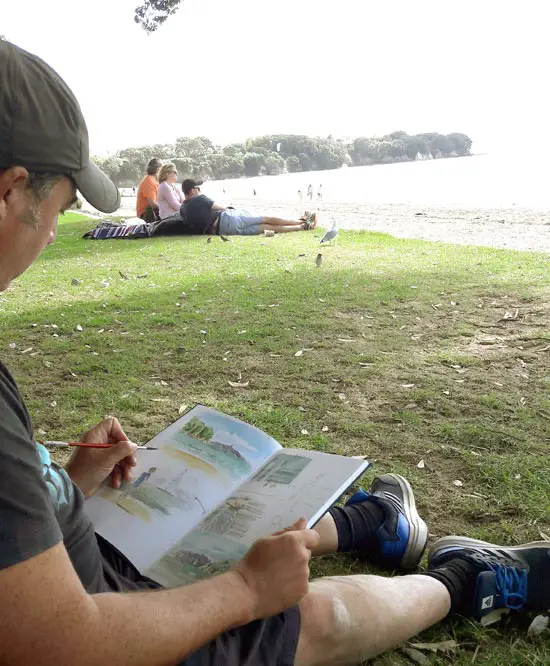
If you’re really reluctant to paint in a public place, drive to a quiet location and paint in your car. The most important thing is to experience as much of the scene as possible at first hand rather than through a camera lens.
20 Tips For Plein Air Watercolor Painting
- Don’t try to do too much at once. Pick simple subjects that can be completed in half an hour or less. Go for the broad strokes that convey the essence of the scene you can always add details later at home.
- Wear a hat with a brim to keep the sun out of your eyes and loose comfortable clothing as you may have to sit in an uncomfortable place or do bit of climbing to get the best vantage point.
- Binder Clips are a useful accessory to have when you need to hold your sketchbook in one hand. Clip them on to your sketchbook to stop the loose pages flapping around. You can also use ringbound sketchbooks or watercolor blocks so that the pages lie flat.. Use heavier paper 300gsm or more to avoid cockling or the need to pre stretch paper.
- I only carry as much as I can fit into a small backback. If you are going to use an easel, it is possible to purchase lightweight collapsible easels specifically for Plein Air painting.
- Take a black or white umbrella with you to shelter from the rain or sun. Avoid coloured umbrellas and bright clothes as these can reflect onto your work affecting your ability to perceive color accurately.
- Remember, light is constantly moving and changing, this can be an advantage and a disadvantage. It’s a disadvantage because the wonderful scene that we are painting may look completely different in ten minutes time.
- You can turn this problem on it’s head and use it to your advantage. Because the other side of the coin is that any location can also be an infinite source of inspiration with it’s constantly changing skies, light direction and weather conditions.
- Take a tip from professional photographers. Photographers know that the best times to get great landscape photos are Early mornings and late afternoons /early evenings when the sun is lower in the sky. When the sun is high, shadows are minimal and the landscape tends to flatten out and become much less interesting.
- Take the minimum number of brushes that you can get away with, two or three brushes should suffice. My brush suggestions are: One round, one Flat and one Rigger size depends on paper.
- Be aware of weather conditions. Strong wind is a problem for the watercolor painter as it can blow dust and sand into your paint and onto your paper. The wind and sun will dry your paint faster than if you were indoors so speed of painting becomes more critical. To mitigate some of these problems. In hot temperatures, wet the back of your paper to stop it drying out too quickly.
- Look for sheltered spots out of wind and direct sunlight.
- Rain obviously will ruin your work and the cold will numb your hands. So wear fingerless gloves to enable you to manipulate your brush while keeping your hands warm. Bright sun will get in your eyes and shine on your paper affecting your perception of color and tonal values.
- Due to their compact and portable design, sets of watercolour pans are generally better than tubes for painting outdoors, especially if you are working at small sizes.
- If you are having difficulty finding a good subject or location, try focusing in on small areas rather than trying to find the perfect panorama. Zoom in on one particular tree, or patch of wildflowers and you will soon realize that any location has infinite potential for subject matter.
- The limitation of photos has been discussed, but a phone camera is still a handy tool to have with you. Composing pictures with your photos means that part of the job is already done when you come to do the painting later.
- Take video in addition to photos. It will help you understand movement. Video is particularly useful for capturing fast moving phenomena such as breaking waves or flying birds. Panning slowly around a scene with a video will yield multiple options for scene selection later on.
- Photos and videos are useful but sketches are even better because sketches tend to leave out the irrelevant and focus on the important details so when collecting reference in this way, make plenty of sketches, as this also serves as a practice run for the final piece that you’re going to complete at home.
- Make notes directly on your sketches about techniques and colors used. This is something I do all the time. There’s nothing more frustrating than being unable to work out what colours you mixed to make that perfect color on your sketch now that you’re trying to recreate it in the studio, possibly days later.
- Avoid masking fluid and masking tape. These items are the enemy of fun spontaneous creation. Masking fluid requires precision patience and time in order to make it work. Masking off borders confines you inside a box, save these items for the more orderly environment of the studio.
- Create individual sets of pan colors tailored specifically for seascapes, landscapes and cityscapes. Limiting your palettes in this way will help you paint faster in the outdoors by cutting down your options.
Minimal Palette Recommendations
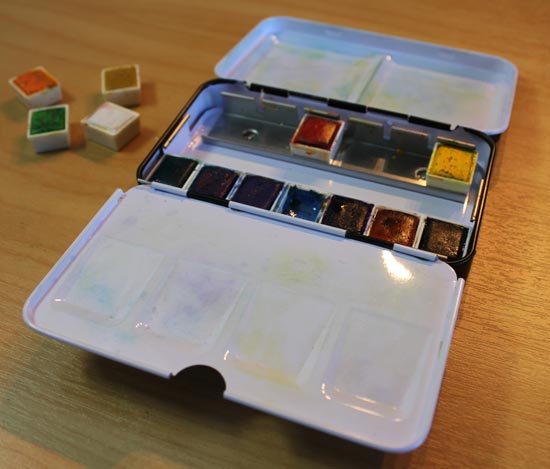
Seascape and Beach scenes will require a predominance of strong blues blues and blue greens such asCerulean Blue, Ultramarine, Viridian, Pthalo Blue. Burnt Sienna applied in thin washes is perfect for sand.
Landscapes will require you to mix a range of greens of different tonal values and color temperature. Prussian Blue, New Gamboge, Paynes Grey, Cadmium Yellow Ultramarine Burnt Sienna and Burnt Umber earthy neutrals.
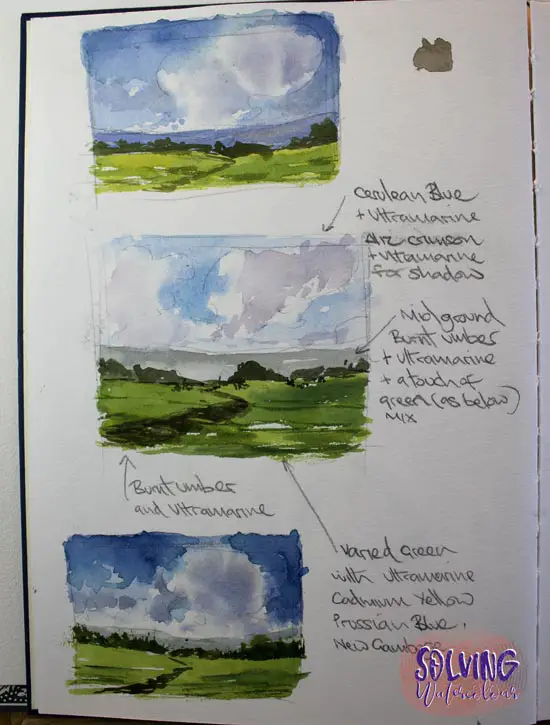
Cityscapes will require some Neutral Grays and some strong bright accent colours such as Cadmium Red or Dioxazine Purple
Plein Air watercolour Painting Tips From The Pros
The Knowledgeable painter works in both places (Indoors and outdoors). A great advantage of outdoor painting is the availability of an abundance of subject matter…Also, when working from “Real life” the outdoor painter can walk up to, around, or behind the subject for another view to help understand it.” – Tony Couch
“All in all, I think the benefits of experiencing the reality of a scene, being outdoors and painting there, outweigh all the disadvantages – The discomforts of weather, the blinding sun, the bugs (and in my case, even bears) because the whole scenario sometimes yields a painting you could not have produced any other way.” – Nita Engle
Master painter Joseph Zbukvic has some thoughts on Plein Air painting too, This quote was taken from his from his book Mastering Atmosphere & Mood in Watercolor.
” When I judge art competitions it’s easy to see which paintings were done exclusively in the studio from photographs. In my opinion, these paintings lack the freshness and spontaneity of work done on location. Many people work from photographs, but it is important to realize that the camera merely records a flat visual pattern. It cannot discern mood… In photographs the tonal values are totally skewed… showing no recession of tone with distance.”
Recommended Equipment For Plein Air Watercolor Painting
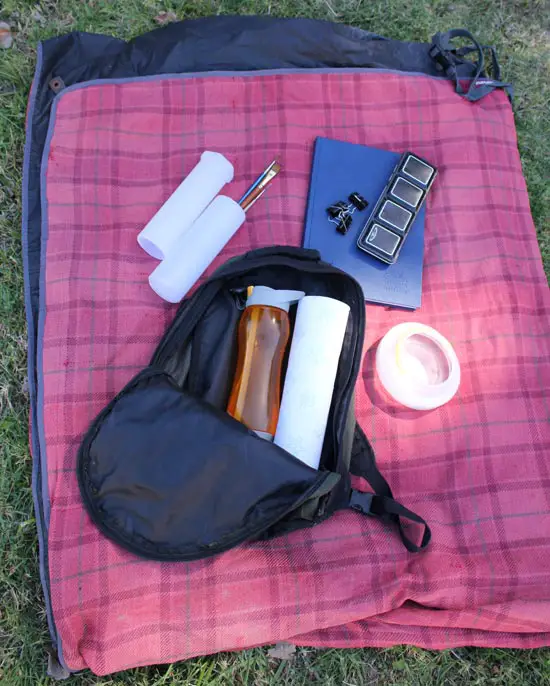
Below, I’ve made a wish list of everything you’re ever likely to need for a Plein Air painting expedition. With links to where you can buy the products on Amazon where appropriate.
Backpack. If you are clambering over rocks or trekking through the woods, it helps to have both hands free.
Large water bottle. You may not have access to fresh clean water in your chosen location so make sure you carry some with you.
Shop For water bottles on Amazon.
Brushes. I’ve discussed brushes already but I do like the look of this Plein Air set from Jack Richeson.
Collapsible water container. I have a similar one to this one on Amazon, It can hold plenty of water and doesn’t take up much space when packed away.
Portable camping chair. This style of fold up camping chair would work well for painting you can even keep your water container in the built-in drinks holder.
Hat. Berets may make you look the part, but something with wider brim like these stylish Straw Fedoras are of more practical use out in the field.
Paper Towels are a necessity for any watercolor painter but they are particularly useful in the outdoors for drying brushes cleaning off your palette etc.
Paint. If you using a set of watercolor pans, the container itself doubles as a palette so you probably don’t need to carry a separate one but if you’re only using tubes, then of course you will. Take a zip lock plastic bag to put it in after use to avoid getting wet paint everywhere.
I recommend this set of Winsor & Newton half pans for quality and portability.
Pencils, erasers. Painting is first and foremost about drawing. You may find that you are still able to make sketches even in situations where painting is impractical. As I’ve mentioned sketches are probably more useful than photos So don’t forget to take some pencils and erasers with you. A small set of artists sketching pencils and carry-case like this is ideal.
Picnic Rug. You may find yourself having to sit in a cold or damp surface when painting outdoors, I often use a picnic rug rather than a chair but either works.
Shop For Picnic Rugs On Amazon
Pochade Box/Portable easel. A Pochade box is a portable box that can be use to store all your painting equipment in. They can often double as easels. Check out this comprehensive guide from VirtualAcademy.com.
Shop for Pochade Boxes on Amazon
Watercolour Sketchbook. There’s no substitute for good quality watercolor paper. You get what you pay for basically. This Canson ring bound sketchbook is idea for outdoor use has good thick 140lb / 300gsm paper stock and comes at a reasonable price.
Umbrella (Black or white not coloured). This Artists/Photographer’s umbrella has a collapsible stand that can be inserted into the ground and wind vents for stability. so you don’t have to hold on to it while you are trying to paint.
